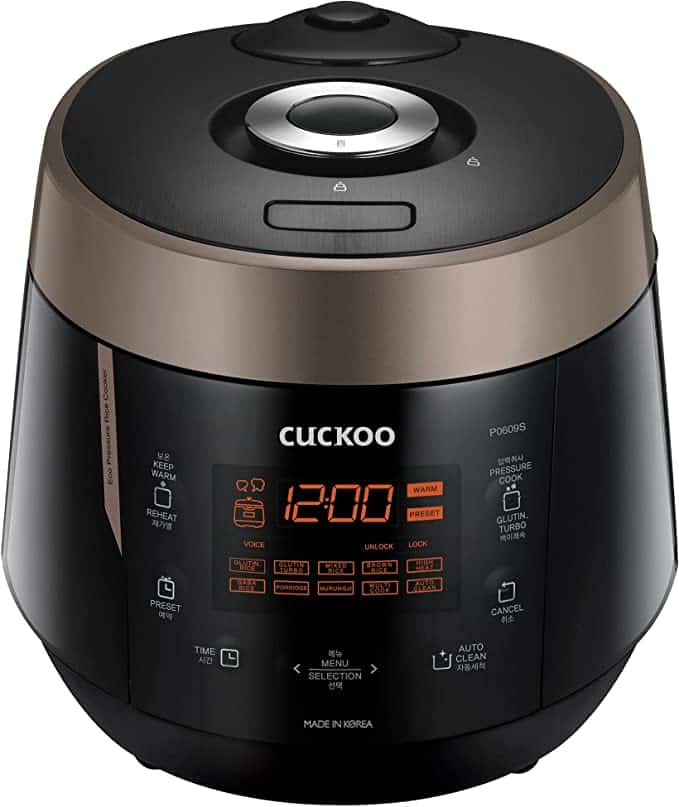Are you a fan of Japanese cuisine and curious to know how to cook Japanese rice in rice cooker? Do you love indulging in sushi, donburi, or teriyaki chicken bowls? If so, you must know that the foundation of all these dishes is the humble yet essential ingredient – Japanese rice.
Cooking Japanese rice ideally is an art form in itself. The right texture, flavor, and aroma can make all the difference in elevating a dish from good to excellent. And the best way to cook Japanese rice at home is by using a rice cooker.
But if you’re new to Japanese rice or rice cookers, don’t worry. In this blog post, I’ll guide you through cooking Japanese rice in a rice cooker. From choosing the right rice to correctly measuring the water, I’ll share all the tips and tricks you need to make the perfect Japanese rice bowl. So let’s get started!
Tools require for cooking perfect rice:
Why use a Japanese rice cooker?

Using a Japanese rice cooker is the easiest and most efficient way to cook Japanese rice. There are several reasons why a rice cooker is a must-have kitchen appliance for anyone who loves Japanese cuisine:
Consistency:
A rice cooker ensures that the rice is cooked consistently every time. The temperature and timing are controlled automatically. That’s the reason why you don’t have to worry about overcooking the rice.
Convenience:
Cooking rice in a rice cooker is extremely convenient. Once you’ve measured the rice and water, turn on the cooker and let it do the job. You don’t have to monitor the rice or adjust the heat like a stove.
Time-saving:
A rice cooker saves time and effort. You don’t have to watch the rice while it’s cooking, so you can focus on preparing other dishes or doing other tasks in the kitchen.
Customizable settings:
Many rice cookers come with customizable settings that allow you to adjust the cooking time and temperature according to your preferences. This is especially useful if you’re cooking different types of rice or experimenting with different recipes.
Energy-efficient:
Cooking rice in a rice cooker is energy-efficient because it uses less electricity than a stove. Rice cookers also have a keep-warm function that allows you to keep the rice warm without using additional energy.
Overall, a Japanese rice cooker is essential for anyone who loves Japanese cuisine or wants to cook perfect rice every time with minimal effort.
Here’s how to cook Japanese rice in rice cooker
Measure the rice:
Use a measuring cup to measure the rice you want to cook. One cup of uncooked rice will yield about two to three cups of cooked rice.
Rinse the rice:
Place it in a mesh strainer and rinse the rice properly with a rice washer under cold running water until it is clear. This removes excess starch and impurities and ensures that the rice cooks evenly.
Add water:
Add the rinsed rice to the rice cooker bowl and water according to the rice-to-water ratio recommended by the manufacturer. For example, add 1 1/4 cups of water to one cup of rice.
Soak the rice:
Soak the rice in the water for at least 30 minutes before cooking. This helps to make the rice fluffy and tender.
Cook the rice:
Now turn on the rice cooker and let it do its work. The rice cooker will automatically turn off once the rice is cooked.
Let the rice rest: Once the rice cooker has turned off, let the rice rest for about 10-15 minutes. This allows the steam to redistribute throughout the rice and makes it fluffier.
Fluff the rice:
Use a rice paddle or a fork to fluff the rice gently. This helps to release excess steam and prevents the rice from becoming too sticky.
Serve the rice:
Scoop the rice into bowls and serve it hot. You can also use the rice to make Japanese dishes like sushi, donburi, or onigiri.
Different ways of serving Japanese rice
Japanese rice is a staple in Japanese cuisine used in various traditional and modern dishes. Here are some ways Japanese rice is served:
As a side dish: In traditional Japanese meals, rice is often served as a side dish alongside other main dishes like fish, meat, or vegetables. The rice is usually plain and is meant to complement the flavors of the other dishes.
Sushi:
Sushi is one of the most popular Japanese dishes made with vinegared Japanese rice, usually topped with raw fish, seafood, or vegetables. The rice is seasoned with vinegar, sugar, and salt, giving it a slightly tangy flavor.
Donburi:
Donburi is a Japanese rice bowl dish with a bowl of rice topped with various ingredients like meat, seafood, vegetables, or egg. Some popular donburi dishes include katsudon (breaded pork cutlet), oyakodon (chicken and egg), and gyudon (beef and onion).
Onigiri:
Onigiri are Japanese rice balls usually filled with savory filling like salmon, tuna, or pickled plum. They are often wrapped in seaweed and are a popular snack or lunch option in Japan.
Modern fusion dishes:
In recent years, there has been an increasing trend of modern fusion dishes incorporating Japanese rice in new and creative ways. For example, poke bowls, a Hawaiian dish made with raw fish and vegetables, often use Japanese rice as the base. Other examples include sushi burritos, sushi burgers, and sushi bowls.
Whether you prefer classic Japanese dishes or more innovative fusion cuisine, there is always a delicious way to enjoy Japanese rice.
Ideas for topping and seasoning Japanese rice.
Here are some ideas for topping and seasoning Japanese rice:
Furikake:
Furikake is a Japanese seasoning blend of dried fish, seaweed, sesame seeds, and other flavorful ingredients. It is often sprinkled over Japanese rice to add a savory, umami flavor. Many different varieties of furikake are available, including ones with shrimp, wasabi, and even egg.
Soy sauce:
Soy sauce is is often used to season Japanese rice. Drizzle soy sauce over the rice and mix it for a delicious, savory flavor.
Grilled eel: Grilled eel, or unagi, is a popular topping for Japanese rice. It is usually marinated in a sweet and savory sauce and grilled until tender. The eel is then sliced and placed over a bed of rice for a flavorful and satisfying meal.
Pickled vegetables:
Pickled vegetables like cucumbers, carrots, and daikon radish are common side dishes in Japanese cuisine. They are also a great topping for Japanese rice, adding a tangy, refreshing flavor.
Fried egg:
A simple fried egg can add flavor and texture to Japanese rice. Fry an egg in a little bit of oil or butter and then place it over a bed of rice. The yolk will add richness to the dish, while the crispy edges of the egg provide a nice crunch.
Teriyaki sauce:
Teriyaki sauce is often used as a marinade for meat or seafood, but it can also be drizzled over Japanese rice for a delicious flavor boost.
Overall, there are endless ways to top and season Japanese rice. Whether you prefer savory or sweet, traditional or modern, there is always a way to make Japanese rice more delicious and satisfying. So, get creative and experiment with different toppings and seasonings to find your perfect combination!
Share some interesting facts about Japanese rice and its significance in Japanese cuisine.
Here’s how to choose the best rice cooker for cooking Japanese rice.
Look for a rice cooker with a specific “Japanese rice” setting
Rice cookers with a specific setting for Japanese rice are designed to perfectly cook short-grain rice. This setting will ensure the rice is cooked at the correct temperature and time.
Consider the size of the rice cooker.
Rice cookers come in different sizes, so consider how much rice you cook at once. If you have a large family or like to cook in bulk, choose a rice cooker with a larger capacity.
non-stick inner pot
Japanese rice can be sticky and can sometimes stick to the bottom of the pot. To prevent this, choose a rice cooker with a non-stick inner pot. This will make cleaning easier and ensure the rice doesn’t stick to the bottom.
Look for a rice cooker with fuzzy logic technology
Fuzzy logic technology is a feature found in some rice cookers that allows the cooker to adjust cooking time and temperature. It ensures the rice is cooked to perfection every time, regardless of the type of rice being used.
Consider the price
Rice cookers come in various prices, so consider how much you are willing to spend. While more expensive models may have more features, a basic rice cooker can still produce excellent results.
Read reviews and do your research.
Before purchasing, read reviews and research to ensure that the rice cooker you choose has a good reputation and is known for producing excellent results. Look for models that are easy to use, clean, and have a good track record for cooking Japanese rice.
By following these tips, you can choose the best rice cooker for cooking delicious and perfectly cooked Japanese rice every time.
Tips on how to measure the rice
Sure, here are some tips on how to measure the rice for cooking Japanese rice:
Use a measuring cup: To ensure that you get the correct rice ratio to water, use a measuring cup to measure the rice. A standard measuring cup holds around 180ml of rice.
Use the markings on the rice cooker: Many rice cookers come with markings on the inner pot that indicate how much rice to add. Use these markings as a guide when measuring the rice.
Rinse the rice before measuring: To remove any excess starch and debris, rinse the rice thoroughly before measuring. Put the rice in a strainer and rinse it under cold water until the water runs clear.
Use the right amount of water:
Ratio of rice to water can vary depending on the kind of rice youre using and the desired texture. Generally, use a 1:1.1 to 1:1.2 ratio of rice to water. For example, if you cook 1 cup of rice, use between 1.1 and 1.2 cups of water.
Adjust the water level based on the rice cooker: Some rice cookers require slightly more or less water than others, so adjust the amount of water based on the instructions provided with your rice cooker.
Conclusion
Cooking Japanese rice in a rice cooker is a simple and convenient way to prepare this staple food. By choosing the right rice cooker, measuring the rice correctly, and seasoning it with delicious toppings and seasonings, you can create a delicious and healthy meal enjoyed by many worldwide. Japanese rice is an important part of Japanese cuisine and culture, and its significance is reflected in the attention given to its preparation and presentation.
With a little practice and patience, anyone can learn to cook Japanese rice perfectly and enjoy this wonderful food’s unique flavor and texture.

